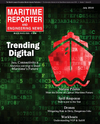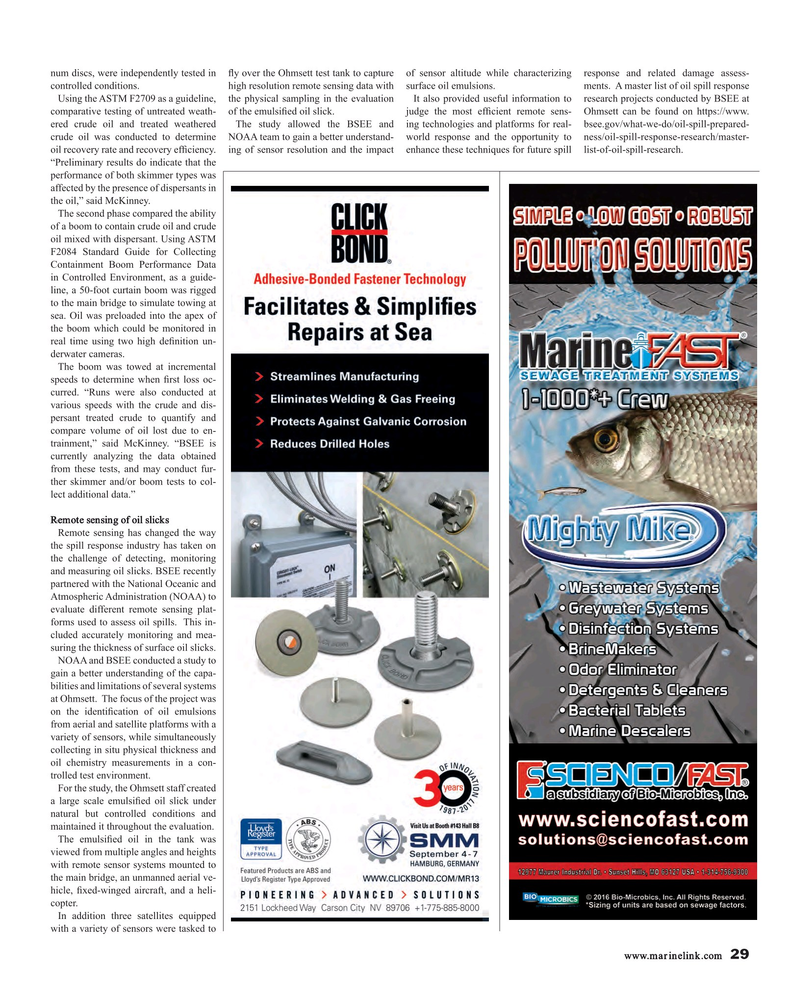
Page 29: of Maritime Reporter Magazine (July 2018)
Marine Communications Edition
Read this page in Pdf, Flash or Html5 edition of July 2018 Maritime Reporter Magazine
num discs, were independently tested in ? y over the Ohmsett test tank to capture of sensor altitude while characterizing response and related damage assess- controlled conditions. high resolution remote sensing data with surface oil emulsions. ments. A master list of oil spill response
Using the ASTM F2709 as a guideline, the physical sampling in the evaluation It also provided useful information to research projects conducted by BSEE at comparative testing of untreated weath- of the emulsi? ed oil slick. judge the most ef? cient remote sens- Ohmsett can be found on https://www.
ered crude oil and treated weathered The study allowed the BSEE and ing technologies and platforms for real- bsee.gov/what-we-do/oil-spill-prepared- crude oil was conducted to determine NOAA team to gain a better understand- world response and the opportunity to ness/oil-spill-response-research/master- oil recovery rate and recovery ef? ciency. ing of sensor resolution and the impact enhance these techniques for future spill list-of-oil-spill-research. “Preliminary results do indicate that the performance of both skimmer types was affected by the presence of dispersants in the oil,” said McKinney.
The second phase compared the ability of a boom to contain crude oil and crude oil mixed with dispersant. Using ASTM
F2084 Standard Guide for Collecting
Containment Boom Performance Data in Controlled Environment, as a guide- line, a 50-foot curtain boom was rigged to the main bridge to simulate towing at sea. Oil was preloaded into the apex of the boom which could be monitored in real time using two high de? nition un- derwater cameras.
The boom was towed at incremental speeds to determine when ? rst loss oc- curred. “Runs were also conducted at various speeds with the crude and dis- persant treated crude to quantify and compare volume of oil lost due to en- trainment,” said McKinney. “BSEE is currently analyzing the data obtained from these tests, and may conduct fur- ther skimmer and/or boom tests to col- lect additional data.”
Remote sensing of oil slicks
Remote sensing has changed the way the spill response industry has taken on the challenge of detecting, monitoring and measuring oil slicks. BSEE recently partnered with the National Oceanic and
Atmospheric Administration (NOAA) to evaluate different remote sensing plat- forms used to assess oil spills. This in- cluded accurately monitoring and mea- suring the thickness of surface oil slicks.
NOAA and BSEE conducted a study to gain a better understanding of the capa- bilities and limitations of several systems at Ohmsett. The focus of the project was on the identi? cation of oil emulsions from aerial and satellite platforms with a variety of sensors, while simultaneously collecting in situ physical thickness and oil chemistry measurements in a con- trolled test environment.
For the study, the Ohmsett staff created a large scale emulsi? ed oil slick under natural but controlled conditions and maintained it throughout the evaluation.
The emulsi? ed oil in the tank was viewed from multiple angles and heights with remote sensor systems mounted to the main bridge, an unmanned aerial ve- hicle, ? xed-winged aircraft, and a heli- copter.
In addition three satellites equipped with a variety of sensors were tasked to www.marinelink.com 29
MR #7 (26-33).indd 29 MR #7 (26-33).indd 29 7/5/2018 12:01:09 PM7/5/2018 12:01:09 PM

 28
28

 30
30
